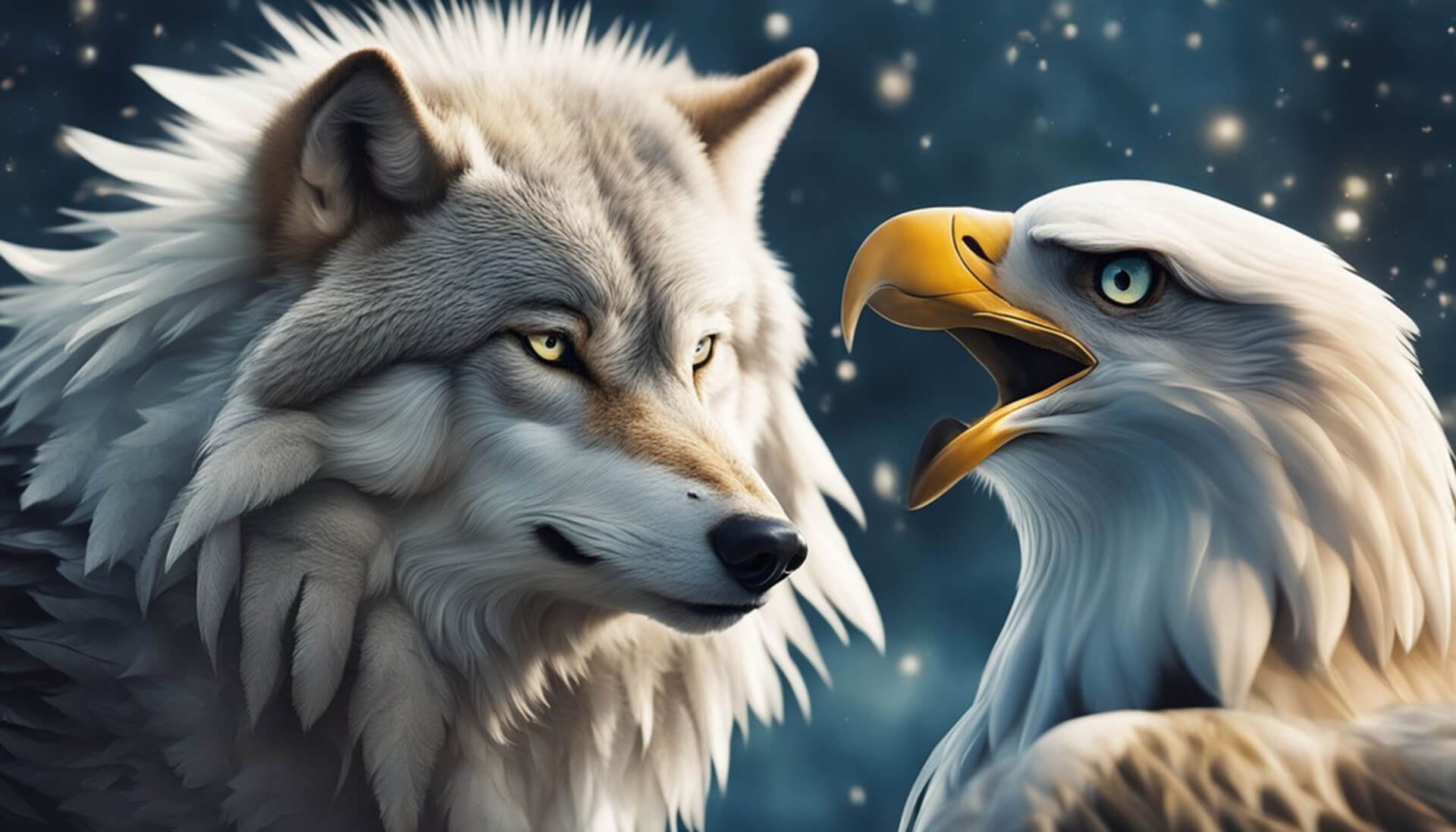Exploring the concept of spirit animals can offer valuable insights into our personalities, traits, and life paths.
The notion of spirit animals originates from various indigenous cultures, where they serve as guides or protectors. They reflect characteristics we might embody or should aspire to cultivate.
May, a unique month within the year, is associated with its own spirit animal. This animal carries symbolic meanings for individuals born during this time or those encountering this animal’s energy.
Spirit animals provide a unique way to connect with nature and the spiritual world, embodying qualities significant to personal growth and understanding.
By examining our relationship with these totems, we might become more aware of our connection to the environment and the living creatures that inhabit it.
May’s spirit animal invites us to explore specific attributes and consider how we can integrate these virtues into our daily lives.
Understanding Spirit Animals

Spirit animals symbolize personal power, guidance, and aspects of oneself. They are often considered representations of characteristics one is meant to learn or embody.
Recognizing a spirit animal can lead to personal growth and a deeper understanding of one’s journey and challenges.
Symbolism: Each spirit animal has its meaning and symbolizes different elements of life.
For instance, a bear may embody inner strength and assertiveness, whereas an eagle could symbolize vision and freedom.
The animal’s attributes are often seen as a mirror to one’s abilities or potential.
Relationships: A spirit animal can influence how one interacts with others and perceives relationships. Owning qualities such as the wolf’s loyalty or the owl’s wisdom can enhance one’s approach to personal and professional relationships.
Guidance: Spirit animals can provide insight and direction during times of uncertainty. They are thought to offer spiritual guidance, helping individuals navigate life’s trials and opportunities.
Personal Growth: Embracing the qualities of one’s spirit animal can stimulate personal growth. It encourages introspection and can promote self-awareness and confidence in one’s life path.
It is essential to approach spirit animals with an open mind and consider what they reflect about one’s journey.
While some might connect intensely with a single animal, others may find that different animals represent various aspects of their lives at different times.
Related: How to Find Your Spirit Animal
May’s Significance

May holds a special place in various traditions and is often associated with renewal and growth.
Historically, cultures worldwide recognize the fifth month of the year as a time of significant transition. This period marks the end of spring and the beginning of summer, a shift celebrated in many festivals and rituals that illustrate the themes of fertility, abundance, and new beginnings.
In terms of spirituality, many individuals seek guidance from spirit animals to illuminate the path forward.
The concept of a spirit animal is rooted in the belief that these animal guides can offer insights into one’s character and future.
May’s spirit animal has distinctive attributes that can be reflected upon for divination and understanding one’s journey.
- The giraffe, symbolizing the ability to see things from different perspectives, encourages adaptability and self-acceptance.
- The deer, representing grace and intuition, gently reminds us of the importance of sensitivity and peace.
These spirit animals connected to May carry nuanced meanings that encourage individuals to embrace their unique qualities and to use them as a compass for navigating the future.
In the realm of divination, May is an opportune time for one to reconnect with one’s inner self and seek clarity in one’s personal aspirations.
It activates an exploration of potential, channeling the rich symbolism tied to May’s spirited fauna to support individuals in their quest for personal growth and self-discovery.
Native American Origins of Spirit Animals

The concept of Spirit Animals is deeply embedded in Native American traditions and is not a novelty for entertainment purposes.
These animals are considered guides and protectors, providing wisdom and support, believed to be granted by the natural and spiritual worlds working in harmony.
Each Spirit Animal is symbolic, carrying its unique significance and teachings influenced by its habits and traits.
Traditions vary among tribes, but there’s a common belief that these spirit helpers are connected to individuals and communities throughout their lives.
They do this sometimes through specific rituals, meditation, or visualization practices.
Unlike the common misuse of the term as a trendy label for a favorite animal, in Native American cultures, an individual doesn’t choose their Spirit Animal.
Instead, it is said to choose them based on their character, life experiences, and innermost qualities.
Table: Common Native American Spirit Animals and Their Symbolism
| Spirit Animal | Representing |
| Eagle | Vision, Freedom |
| Bear | Strength, Leadership |
| Wolf | Loyalty, Courage |
Spirit Animals’ teaching emphasizes a connection to the land and its creatures, fostering a deeper understanding and respect for nature as a whole.
They’re considered sacred and respected components of Native American spirituality and worldview. The approach to Spirit Animals is one of reverence, an integral part of a broader, harmonious relationship with the ecosystem.
Interpreting Signs and Symbols

Interpreting signs and symbols can be a subtle process, requiring one to tap into one’s intuition and connect deeply with one’s surroundings.
Spirit animals often communicate wisdom and insight through various signs and symbols in one’s environment.
Signs may come in the form of:
- Repeated encounters with a particular animal or imagery
- Dreams or visions where the animal appears
- Natural phenomena coinciding with thoughts or emotions
On the other hand, symbolism can be more abstract, representing attributes of the spirit animal that resonate with one’s current life situation.
Key Aspects of Spirit Animal Symbolism:
| Symbolism | Associated Insights |
| Eagle | Vision, freedom, and a call to view life from a higher vantage point |
| Bear | Strength, courage, and the need for self-reflection or protection |
| Wolf | Community, loyalty, and finding one’s path or calling |
To accurately interpret these, individuals should consider their reactions and feelings towards these encounters.
Keeping a journal to track these experiences and reflect on the common themes and messages can be beneficial.
Using intuition, the person can decide whether the sign is a coincidence or something of greater significance.
This process helps one derive personal meaning and guidance from spirit animal encounters, leading to self-discovery and growth.
Exploring Common Spirit Animals

Spirit animals embody traits we admire and aspire to integrate into our lives.
Common spirit animals guide individuals with their unique qualities and wisdom.
- The Wolf: Known for its intelligence and courage, the wolf spirit represents a deep connection with instincts and an appetite for freedom.
- The Deer: With a graceful and gentle presence, the deer spirit animal symbolizes innocence and a tranquil energy that soothes and calms.
- The Owl: Esteemed for its elegance and wisdom, it offers the ability to see beyond the obvious, often associated with insight and intuition.
- The Eagle: The eagle soars high, symbolizing vision and personal sovereignty; it’s a spirited guide for those who seek determination and courage.
- The Fox: Renowned for being clever and cunning, the fox spirit teaches the art of adaptability and the importance of utilizing one’s surroundings to thrive.
- The Bear: Embodying strength and self-confidence, the bear symbolizes leadership and the necessity of rest and solitude for personal growth.
Attributes of Selected Spirit Animals

Spirit animals are considered to embody the traits and qualities that they represent in various cultures.
Understanding these attributes can provide insights into one’s life and the challenges one may face.
Here is a closer look at the characteristics associated with some spirit animals.
The Cat
The cat is synonymous with independence and curiosity. Often seen as having nine lives, the feline embodies resilience and the ability to stand on its own two feet regardless of the situation.
The Bear
A symbol of power and protection, the bear also carries a sense of bravery with it. Bears represent standing strong against adversity and taking action when necessary.
The Dolphin
Dolphins are celebrated for their playfulness and their extraordinary ability for communication. They also encourage balance and joy in one’s life.
The Horse
Embodying freedom and the thrill of adventure, the horse has long been associated with an ability to travel physically and spiritually across various terrains of life.
The Butterfly
The delicate butterfly signifies transformation, delicacy, and lightness. As a butterfly undergoes metamorphosis, so can individuals embrace change and personal growth.
The Hawk
Known for its keen vision and focus, the hawk is a message-bearer. It reminds one to pay attention to the larger perspective and to environmental signals.
The Tiger
Exuding willpower and ferocity, the tiger implies a sense of self-assuredness. This spirit animal encourages assertiveness and trust in one’s instincts.
The Elephant
The elephant symbolizes memory and commitment but also underscores the importance of community. It represents the ability to overcome obstacles through recollection and collective effort.
Incorporating Spirit Animals into Daily Life

Incorporating spirit animals into one’s daily routine can foster a deeper connection with oneself and the qualities they represent. They can act as guides, offering support and development in various aspects of life.
Meditation is a crucial practice for attuning to a spirit animal. By visualizing the animal in a tranquil state, individuals may discover insights related to their traits, such as trust and loyalty.
Featured Partner Offer
1. Headspace AppFeatured
〉 Hundreds of meditation videos, breathing exercises, and podcasts
〉 Daily routines & schedules accessible on the app or website.
〉 Diverse Content for Every Mood
〉 Engaging and User-Friendly Interface
This reflective time provides clarity and can reinforce personal beliefs in the guidance of spirit animals.
Incorporating the essence of a spirit animal can also manifest in acknowledging one’s dreams. Keeping a journal of dreams where the spirit animal appears could serve as a tool for understanding subconscious messages.
These dreams may convey essential guidance or affirm one’s path.
Trust in the process is crucial. Believing in the significance of one’s spirit animal enhances the bond and allows its qualities to support personal growth.
Individuals may find that this trust translates into increased self-reliance and a fortified sense of loyalty towards their values and relationships.
In the realm of development, embodying the attributes of a spirit animal might entail adopting behaviors or mindsets that align with the animal’s characteristics.
This can range from a bear’s assertiveness to a dolphin’s playfulness, all aimed at personal enhancement.
Lastly, featuring symbols of the spirit animal in one’s environment, such as artwork or tokens, acts as a reminder of their presence and influence.
It’s a way to keep the connection alive and draw upon their energy for daily support.
Engagement with spirit animals is a personal journey substantiated by conscious actions and openness to their symbolic significance.
Spirit Animals and Personal Development

Spirit animals have long been recognized in various cultures as carriers of guidance and symbolic representations of a person’s traits and qualities. They encourage self-reflection and inner strength, providing a unique perspective on personal growth and development.
One’s spirit animal is more than a symbol; they are believed to offer direction in challenging times.
For instance, if an individual identifies with the bear as their spirit animal, they may tap into the bear’s strength and confidence during personal trials, using this period to heal and nurture their own needs or support others.
| Spirit Animal | Associated Trait | Developmental Aspect |
| Wolf | Intuition | Fosters trust in one’s own instincts. |
| Owl | Wisdom | Enhances decision-making skills. |
| Eagle | Vision | Assists in setting and achieving goals. |
Through practicing introspection, individuals can discover their spirit animal, reflecting personal aspirations or innate characteristics.
Those with the wolf as their spiritual guide may cultivate loyalty and independence, learning to trust their intuition, as Joyful Simply describes.
Note: Reflecting on the qualities of spirit animals can inspire people to adopt certain traits and integrate them into their journey, fostering a sense of empowerment and purpose.
Environmental Conservation and Respect

Environmental conservation reflects a deep respect for the natural world and the myriad forms of life it sustains. It involves safeguarding ecosystems and preserving biodiversity, ensuring the animal kingdom thrives for future generations. As guardians of our planet, humans are responsible for maintaining the delicate balance of nature.
- Conservation Efforts: Humans must engage in proactive strategies to protect endangered species and restore habitats. This could involve establishing protected areas, enforcing anti-poaching laws, and supporting sustainable land use practices.
- Respect for Wildlife: It is crucial to treat all creatures with respect, recognizing their intrinsic value beyond human use. Harmful actions towards animals undermine conservation efforts and disrupt ecological harmony.
- Guardian Role: Those dedicated to environmental protection often act as guardians, advocating for policies and behaviors that benefit the environment. Their unwavering commitment inspires others to act with similar reverence for our planet.
Promoting Awareness: Education plays a vital role in fostering a culture of conservation and respect. By increasing public awareness regarding the importance of biodiversity, individuals are more likely to support conservation initiatives.
Collaboration: Achieving meaningful conservation outcomes requires collaboration among governments, NGOs, and communities. Only through united efforts can long-term sustainability be accomplished.
By approaching environmental conservation with respect, one acknowledges the interconnectedness of all life.
The survival of countless species, including humans, depends on collective efforts to protect and honor the natural world.
Conclusion
The spirit animals linked to May offer a rich tapestry of symbolism and meaning. They signify various traits that one can draw upon to foster personal growth.
The giraffe is a beacon of perspective and adaptability, urging one to embrace uniqueness and live authentically. This encourages a journey towards self-acceptance and the courage to express oneself freely.
On another note, the raccoon represents resourcefulness and the ability to uncover hidden truths.
Those identifying with this creature are reminded to navigate challenges with adaptability and intelligence.
Furthermore, deer are widely regarded as graceful and gentle guides. Their presence in May’s spiritual imagery conjures notions of sensitivity and peace.
One is called to harness the deer’s qualities to navigate life’s challenges with grace and intuition.
In this month, individuals are encouraged to reflect on these animals’ characteristics:
- Giraffe: Perspective, Adaptability, Self-Acceptance
- Raccoon: Resourcefulness, Secrets, Adaptability
- Deer: Grace, Intuition, Gentleness
By assimilating these traits, one can aspire to lead a life aligning with the strengths and wisdom each spirit animal symbolizes.
These reflections can help guide personal journeys and decision-making as the month progresses.
Frequently Asked Questions
The concept of spirit animals is steeped in tradition and personal reflection. This section addresses questions regarding the association of birth months with spirit animals and the specifics of the spirit animal for May, enriching the understanding of their symbolic significance.
1. How can one determine their spirit animal based on their birth month?
One can determine their spirit animal based on their birth month by reflecting on the characteristics and qualities traditionally associated with that month. Cultural beliefs and astrology often link spirit animals with birth months.
2. What is the significance of a spirit animal for someone born in May?
For someone born in May, their spirit animal holds symbolic significance. It often reflects the growth, vitality, and renewal characteristic of spring. The spirit animal can act as a guiding force or mirror personal attributes.
3. How does the spirit animal of the Taurus zodiac sign relate to people born in May?
The spirit animal associated with the Taurus zodiac sign, which includes those born in May, often resonates with Taurian traits such as reliability, patience, and stability. This connection provides deeper personal insight and guidance.
4. What traits are commonly represented by May’s spirit animal?
May’s spirit animal typically embodies traits like grace, beauty, and gentle nature, much like the serene presence of the deer.
5. Are there specific characteristics of the May 31 spirit animal?
While the spirit animal for a specific day, such as May 31, isn’t commonly standardized, it may integrate the overarching themes of May’s animal with unique aspects influenced by other astrological factors.
6. In what ways can a spirit animal chart aid in finding one’s animal linked to their birthday?
A spirit animal chart can be a practical tool to identify the animal linked to one’s birthday.
This is often done by combining astrological signs, birth months, and personal reflection on one’s affinities and traits.









